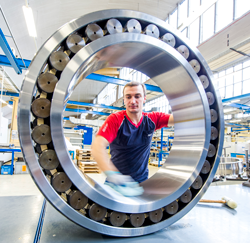Too many bearings are ending up on the waste heap when potentially they could be repaired and placed back into service. But what size and types of bearings make good candidates for repair, as opposed to replacement? David Oliver, Channel and Platform Development Manager, Bearings and Units at SKF, provides the answers.

It is estimated that as many as 90 per cent of all bearings in operation around the world never reach their calculated service life. Apart from the issue of waste and its environmental implications, this stark statistic reveals that too many companies are just not getting the best return on investment in their bearing assets.
Replace or repair?
When the condition monitoring data tells you that a bearing is nearing the end of its useful life, do you start planning for a replacement or do you schedule in a repair job?
A new bearing is going to cost more than a repaired one in virtually every case; moreover, the amount of energy expended in a repair job will be considerably less than that needed to manufacture from scratch вҖ“ as much as 90 per cent less, depending upon the amount of remanufacturing required.
So, what are the economies of scale and the practicalities of remanufacturing a bearing?
Remanufacturing is more appropriate for larger, specialised units where big economies can be realised, though it may also be viable for high volume applications where multiple bearings can be remanufactured en masse.
Remanufacture is possible in over fifty per cent of applications and it may also be possible to remanufacture a bearing, particularly older bearings, to a higher standard of quality, enabling it to perform better вҖ“ and last longer вҖ“ than the original part. Large size bearings suitable for remanufacture are typically found in:
Metals
Mining, mineral processing and cement
Pulp and paper
Wind energy
Remanufacturing: the key stages
Inspection and analysis вҖ“ this will provide information regarding modes of failure, so steps can be taken to ensure that the remanufactured bearing does not suffer in the same way. It will also determine the extent of remanufacturing required, including:
partial remanufacture вҖ“ this is mostly a polishing exercise, reusing existing components;
extensive remanufacture вҖ“ this may involve the wholesale replacement of components and the re-grinding of raceways.
All remanufactured bearings are subsequently quality inspected and marked for traceability before being packed and returned to the customer. Note that unused bearings which may have degraded due to lengthy or incorrect storage can also be fully restored to вҖҳas-newвҖҷ condition.
What is the impact on machine downtime?
It is quite natural to assume that remanufacturing is a time consuming process and as such will impact negatively on machine availability.
In fact, remanufacture (if deemed a viable proposition for the bearing in question) can normally be carried out in a relatively short period of time, with dismounting and refitting scheduled into planned service shutdowns and maintenance operations.
A replacement special unit, on the other hand, could take weeks or months to supply вҖ“ and, of course, cost considerably more.
SKF offers a remanufacturing service that covers all major brands of bearings used throughout the heavy manufacturing industries. In addition to reducing energy use, this service ensures that responsible cleaning methods are used and waste materials appropriately handled, helping to protect the environment.

 Industry News
Industry News